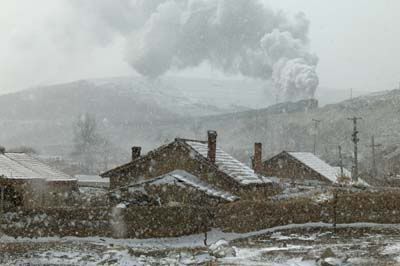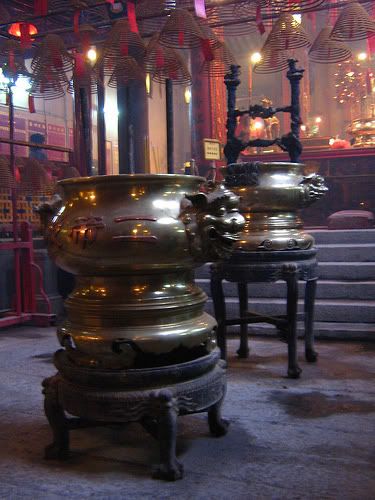Last Man Out
As I've read about these journeys around China, I've been struck by how much more difficult the historian's job becomes as we move into the modern age. The travels of a 7th century monk turn out to be meticulously documented, with details easily verified from contemporary texts and the archaeological record. But, as we draw closer to the present day, things become murkier. We find two, or three, or four versions of the most basic stories. By the mid-1930s we might have a million soldiers engaged, and no two reports corroborating one another. Did 40,000 Communists die at the Xiang River, or did they desert? Did Mao evade Chiang on the Long March, or did Chiang let him go because his son was being held hostage in Moscow? Who fought the Japanese? What really happened at Luding Bridge?
The further into this material I go, the more I think of a children's story by Arnold Lobel:
Toad sipped his tea.
"Frog," he asked,
"are you making this up?"
"Maybe yes and maybe no,"
said Frog.
- Wipe out the triads
- Kill all the drug dealers
- Destroy religion (this is still a Maoist imperative)
- Reinvent agriculture in accordance with Marxist principles

That last item culminated in the Great Leap Forward (1958 to 1961), which led to the starvation of perhaps 20 to 40 million people. There is considerable debate about how many died, and whether or not it was an accident. Some have argued that Mao consciously sacrificed peasants' lives to help gain Superpower status (perhaps trading grain to Russia for nuclear weapons technology). Whatever the motivations, in its stated intentions and results the Great Leap Forward strongly resembled the Plague of Hunger that Stalin inflicted on Ukraine in the early 1930s, known today as the Holomodor.
At the same time, the Communists redoubled their efforts to destroy religious institutions. Monks were were captured, tortured, and killed. George Crane's fine 2000 book, Bones of the Master, describes the experience of a young Ch'an monk caught in this nightmare in Chinese Mongolia:
Yesterday the monks had harvested the last of the cabbage and potatoes. The yellow beans, the wheat, and the millet were finished. China was starving. More than thirty million would die in the next two years. Only bureaucrats and rats would eat...
When would death arrive at Puu Jih? There were stories, rumors sliding from village to village like the hunger. And then last week, late one night, a young lama from Mei Leh Geng Jau lamasery on the Ulansuhai plateau roused them from their beds with his shouting and pounding on the gate. His face was drawn white, thin as paper. His eyes were wild. He told them that the ninth patriarch, the great Ch'an Master Hsu Yun, Empty Cloud, had, at the age of one hundred twenty, been hacked to death by the Communists.
[They] bowed to their master, amazed that he had descended the mountain at night. But the time for ceremony had passed. He grasped each of them by the shoulders and held them for a moment. To Tsung Tsai he said, "Everywhere are hungry ghosts. Go quickly. Keep a strong mind."
Tsung Tsai said nothing. There was nothing to say, no gesture for endings. Soon, he knew, his teacher would forget the world, forget himself, simply let go, and die. He feared his older brothers too would soon be dead, and he could not contemplate the emptiness of the world without them.
Tsung Tsai's fears turn out to be correct - he will be the only one to survive. The book describes his surreal and perilous journey out of China, through a desolate rural landscape. In some places bodies are stacked like cordwood, some with cuts where cannibals have taken organs.
He moves stealthily past the edges of populated areas, knowing no one can be trusted:
The city was dangerous. Jeering mobs eager to prove their revolutionary
integrity hunted "reactionaries," turning on anyone they thought suspect.
He finds a railroad - the one possible way out:

With a few other desperate people, he climbs onto a train, then hangs on for dear life as the walls of a narrow tunnel scrape away his companions, one by one.
Eventually he comes safely to Hong Kong, then to America, and then to George Crane's doorstep. In the mid-1990s the old monk persuades Crane to help him return to Mongolia, find the ruins of his monastery, and seek a bone fragment of his teacher to take as a relic.
"Frog," asked Toad,
"did this really happen?"
"Maybe it did
and maybe it didn't,"
said Frog.
I loved the book, and both Zen teachers (Jack Kornfield) and literary types (Robert Bly, Peter Matthiesen) have reviewed it favorably. But is it a little too well written to be true? Perhaps, some have suggested, George Crane is our generation's Carlos Castaneda?
A few reasons to be skeptical:
- It is hard to believe that a surviving Ch'an monk could wander, undiscovered, around New York for so long. After all, the search for zen masters in my lifetime has been rivaled only by that for Kung Fu instructors from the Shaolin Temple and blues masters from the Delta (was that really Son House?). A real Chinese Ch'an master? With this story? Right here in Woodstock? Sensational.
- Some endorsements have been slightly hedged, e.g., "the style is novelistic, and it is best to read Bones of the Master as if it were a novel." - Dharmalife
- And what about this monastery, Puu Jih (not to be confused with the one in Malaysia)? Crane says the Red Guard blew it up in 1966 and took all the stones away, so there's nothing left. Hmm. In 2000 reviewer Margaret Ramirez wrote: "experts at Harvard and Columbia whom Crane contacted before the trip had no knowledge of Ch'an monasteries in Inner Mongolia and were curious about what he would uncover. The Puu Jih monastery, with its 13 monks, may have been the only such monastery north of the Yellow River." If it existed at all.
Truth is the murkiest, the most illusory of all human constructs. Fact number one: truth and lies both, equally, contradict themselves eventually. Nothing is as it seems. The one thing that all storytellers have in common is a wildly subjective approach to the truth... The only difference between fiction and nonfiction is that with fiction one changes the names.
In Crane's defense, Bones of the Master generally accords with what we know of historical fact, and some of the detail (not to mention the photographs) would be damned difficult to make up. Unlike Castaneda's work, the chronology appears consistent throughout. There is a picture of Crane and Tsung Tsai together on the back of one edition of the book. On Picasaweb there is a photograph of a monk called Tsung Tsai, supposedly taken in 2008, that looks a great deal like the young man on the cover of the book. And shall we admit this testimony, from a woman who says she is Crane's daughter?
I believe Crane's story, mostly on internal evidence. Either this mostly happened, or he is a master of fiction such as I have never seen. Maybe I haven't read enough fiction, but are there many people who could conjure this from thin air?
The cemetery was a half mile west of the village, bounded to the south by a dike. The graves were unmarked mounds of sand and stone. I followed Tsung Tsai. He pointed: “Mama, my two brothers are here.” He bent and placed small pieces of pancakes from our breakfast on each grave. He took a handful of incense sticks that Fang-fang had given him as we left the house. I stood with my parka unzipped and held outstretched, trying to shelter him from the wind. He tried again and again to light them, but it was no use: the wind was too strong.
“Just forget,” he said, and stuck a few on each grave. His eyes closed and his lips moved.
Next, he went to the graves of his father and grandfather and repeated the ceremony. When he finished, he bit his thumb and sobbed, finally giving himself over to grief – for his lost family, his lost world.
I looked down at the rough mound that was his father’s grave. I felt nothing. No reincarnated souls. No hungry ghosts. Another poet whose bones refused to turn to dust.
For all the existential horrors described in Bones of the Master, the one that scared me most, described in an epilogue, is the least amenable to rational analysis. After surviving his journey out of China and his arduous pilgrimage back, Tsung Tsai confronts a different kind of monster. In the apparent safety of Hong Kong in 1997, a former student of his named Lei - a practitioner of black magic - seeks to destroy the old monk and take his power.
Buddhist Temple, Hong Kong

This is serious stuff for a Buddhist. Buddhists believe it is possible to be free of delusion, but it is hard-won, and perhaps only granted to a few. The idea that an advanced practitioner might be deliberately turned and thrown back into the maelstrom is horrifying. Confucius said "one may rob an army of its commander-in-chief; one cannot deprive the humblest man of his free will," but that is precisely Lei's intention.
In their climactic confrontation, the sorcerer begins a hypnotic and dazzling bell ceremony as Tsung Tsai faces him. Crane, in attendance, apparently experiences sensory overload and loses consciousness.
"Frog," asked Toad,
"was that a true story?"
"Maybe it was
and maybe it wasn't,"
said Frog.
The novelist Amy Tan recalls that as a child, her mother thought she had the gift of talking to the dead. Tan herself did not believe she had any such ability. And yet now Tan has changed her mind...
Ten years ago, I clearly saw a ghost, and she talked to me. It was my mother. She had died just 24 hours before. Her face was 10 times larger than life, in the form of a moving, pulsing hologram of sparkling lights. My mother was laughing at my surprise. She drew closer, and when she reached me, I felt as if I had been physically punched in the chest. It took my breath away and filled me with something absolute: love, but also joy and peace — and with that, understanding that love and joy and peace are all the same thing. Joy comes from love. Peace comes from love. "Now you know," my mother said.
I can't say I've had such an experience. I've discussed these things over the years with the sane and the mad, but more than anything have been struck by the unyielding, unforgiving nature of physical reality. Mao showed how efficiently spiritual arguments could be resolved, if you didn't mind using a gun.
Frog and Toad sat
close by the fire.
They were scared.
The teacups shook
in their hands.
They were having the shivers.
It was a good, warm feeling.


1 Comments:
One thing you're convincing me of is that somewhere in these 6 years of bloggery there is a book.
Post a Comment
<< Home